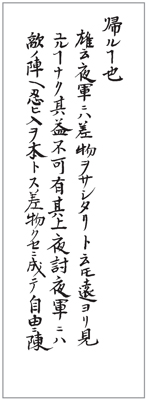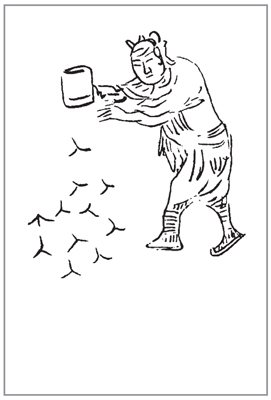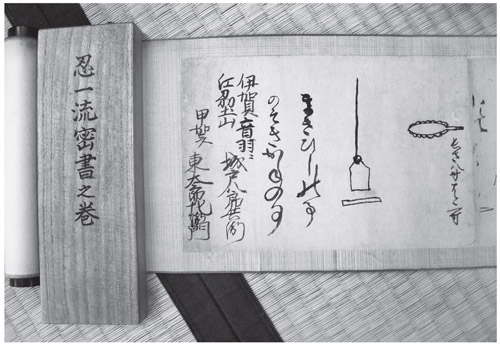Read In Search of the Niinja Online
Authors: Antony Cummins
In Search of the Niinja (32 page)
Shoninki
This section is about the advantage of making people think that they are smarter then you are, with the aim to glean information indirectly from them. You should never divulge your true capabilities for any reason, ever.
To make people reveal their opinions, you should pretend to be too stupid to think reasonably and ask someone to tell you what they think about a certain subject you wish to know about.
People wish to show how intelligent they are and they want to see you as more stupid; therefore you should just disguise your own reasoning power and gain information through listening.
Part of a shinobi’s skill set is to be careful and not show your true intelligence at any time.
A well-trained shinobi looks like a very stupid man. It is a core principle to praise others as much as possible to keep them carrying on about a subject at their own leisure, this skill is called
Hito ni Kuruma wo Kakeru
Shinobi
Night Attacks
Whilst cross-referencing ninja manuals helps to dispel doubts about the authenticity of the skills described, finding references from texts that are external to the world of the shinobi
and can have no agenda at all is more satisfying. Returning to the manuals of the
Otsubo Hon
school of horsemanship, we can start to find correlations not only in the words used to describe shinobi, such as the name
Kamari
and its connections to the ninja, but also in the instructions themselves. The school teaches that when adventuring out on a shinobi mission, you should refrain from taking long weapons such as spears and halberds. The
Bansenshukai
in the section makes the same point: ‘Do not take any long weapons such as spears [on shinobi night attacks]’. Simple instructions such as this help to authenticate the writings of certain shinobi masters. Most attempts at counterfeiting ninjutsu tend to aim at the more dramatic and mystical elements and neglect such apparently mundane matters. Through such relatively unimportant connections we build a more solid argument for the validity of writings such as the
Bansenshukai
and the
Shoninki
.

The
Otsubo
Hon
school talking of shinobi raids.
Shoninki
For those familiar with the teachings of the
Shoninki
the following extracts will certainly ring bells. The similarities imply connection between the two documents. The manual in question is the
Dakko Shinobi No Maki Ryakuchu
, a monograph that offers an exciting visual window into the world of the ninja: It may simply be a list of Natori-ryu skills and so closely associated with the
Shoninki
manual, or if external to Natori-ryu, then both documents spring from the same sources.
In Relation to Wind and Rain
It is beneficial to steal in when it is windy; however it is not so beneficial when it rains as you will leave footprints.
The ‘Black Board’
When you ‘steal in’ and your [presence] has been detected, you should hide under a window, this is because [if someone] examines the outside from a window, they seldom look downwards, so you should carry a ‘black board’ [to cover you]
95
called ‘the window lid’ and thus you will not be found. A shinobi should first of all think of windows [when he infiltrates].
The Pipe
96
Ladder
Place sections of bamboo like that of a smoking pipe onto a rope with a hook on the end, this is called the
Kudanawa Bashigo
or the Pipe Ladder.
The Sword Ladder
When crossing a fence, place your sword against the fence and use the hilt (
tsuba
) as a foot hold so you can climb over the wall.
Iron Spike Steps
The
Kogai Bashigo
: Place iron spikes [
kogai
] into a wall to make footholds so that you can climb up them.
The Collapsible Hook and Rod
Kaginawa Bashigo
: As with the Pipe Ladder above you put bamboo pipes onto a rope with a hook, with this version you can pull the rope [to give it tension].
Securing Doors and Gates
Some gatehouse doors can be opened by [removing] the bar
97
or by keys, therefore tie a rope to the [illegible text] and then secure it to the bottom [to hold fast the door and to stop people entering].
The connections to individual ninja schools and the
Shoninki
manual do not stop there, the ninja manual
Ninpo Mizukagami
written by Fujita Ungyoanryo of Kaga discusses the skill of identifying if an enemy light is approaching or not, at night. The
Shoninki
states that if you place your sword on the ground and use a fan as an upper cross bar and then get a line of sight to the light in question, you can use these as ‘cross hairs’ to see if the light goes up or down, left or right and you can thus determine if the enemy is advancing or not. This is echoed in Fujita’s manual, even though the two schools are over 300km apart:
If you put a paper handkerchief or your sleeve across your eyes and look at the light ahead [you can determine a direction]. If they are moving away from you, you will see the light retreat, however, if they are advancing the light will move down and out of your vision. If the actual distance [of the enemy] is one Cho away it will be in reality three Cho.
The manual continues with a ‘recipe’ for a
Donohi
body warmer, which is a utensil to carry fire or more accurately smouldering embers to start a fire and keep a ninja warm. Whilst the concept is the same in both manuals, the difference in ingredients shows that one is not copied from the other, they are independent during at least the early Edo period.
The
Ninpo Mizukagami
ninja manual held at the Iga Ueno Museum is a document of the
Muhyoshi
school and was passed down in Kaga and Ichizen and consists of two volumes that are dedicated to the shinobi arts, declaring that a
Bushi
(samurai) should know such things, another counter to the samurai versus ninja myth. It is believed that
Muhyoshi-ryu
was an offshoot of a martial school called
Shinjin-ryu
founded by the swordsman Kusabuka Jinshiro Tokinobu of the Kaga domain. The school
Muhyoshi
-
ryu
appears to have been founded by a man named Niki Shinjuro who was a
Yorikigumi
98
and a disciple of the swordsman. It appears he took the school of
Shinjin-ryu
and mixed it with others to form the
Muhyoshi-ryu
, which ended up containing this ninja information. It is unknown how the ninja information entered this school of military arts:
I have collected various kinds of deception and recorded them to aid future generations [in any time of need].
If you have a mighty enemy and you need to make a night attack on your own, you should attack with these shinobi ways.
The concept of using
shinobi no jutsu
or the arts of the ninja for defence is a common theme in ninja writing. It could be the case that these are genuine instructions to future generations, or they might be self-justification by the author who uses what are considered unorthodox strategies including theft; or a mix of the two.
The
Ninpo Sho Ka-zamurai Techo
ninja scroll also strongly echoes the
Bansenshukai
but lists more tools:
The Kurorokagi Latch Finder
This tool is used as a sickle saw. It is made of iron and should be thin, place it between the gap in sliding doors and probe upward, thus finding the lock. This it is called a
Toigaki.
99
However, it has a second use, it can be used as a latch probe, to find the Kuroro latch and open it.
The Saw
This is a
sotogiri
and
uchigiri
– that is an outside and inside cutter.
100
Put the blade into the [unknown text]
101
and cut a wider whole.
The Sound Amplifier
Hang this sound amplifier up like a weight and scales. Next place a plate underneath it with a gap of five Rin [1.5 mm]. With this you can know if those inside are asleep or not and if they are the bell will drop down on to the plate.
Caltrops
Spread or scatter these at every exit when you infiltrate, so that the enemy may not follow. Also on your way out leave them behind you as you retreat.
The ‘snorkel’
Make this of tanned leather and use when you travel underwater – this allows you to breathe.
One superb link between other manuals and ninja lore is this sound amplifier. First the concept of amplifying sound is in the
Shinobi Hiden
and its mentions the use of the shell of the sea usrchin to do the same job, (discussed later). However more interestingly, it is a duplication of ninja folklore, first expressed by Natori in the
Shoninki
. Natori states that if you attach a weight on a thread held just off the floor in an old building, then when the occupants of the house fall asleep, the stone will touch the floor. This is nearly the same description.
102
The only even remotely logical interpetation for this folklore is that the wood of the house contracts as the night gets colder, allowing the weight to hit the floor.
Listening was an important skill in both using ninjutsu and defending against it. The sounds of insects, the behaviour of dogs and frogs, the sound of opening doors, squeaky floorboards and the direction of the wind were taken into account when using ninjutsu. The ‘Listening Cylinder’ came in two basic forms, firstly as an ‘ear trumpet’. This could have been a metal flared cylinder or even the shell of a sea urchin, as described in the
Shinobi Hiden
manual and was used by pushing it through holes in walls or through lattice work. The second version consisted of a cylinder open at only one end on a string, as illustrated right. A shinobi would hold it next to an open window or next to a hole he had scraped out of a clay wall so that he conversation of the people in the room might be heard. Both of these examples show how close a ninja had to approach an enemy.

Caltrops are a worldwide phenomenon; however a possible ninja connection can be seen with this image from the Chinese manual.

